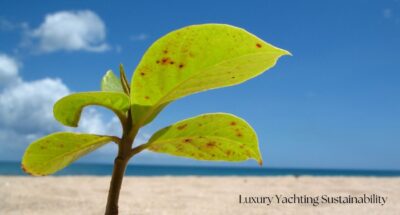As the world shifts toward sustainability, even the ultra-luxury world of superyachts is feeling the pressure to go green. But can a multi-million-dollar floating mansion ever truly be “carbon-neutral”? While hybrid-electric propulsion and solar-paneled decks are making headlines, the reality is far more complex. From eco-friendly materials to sustainable operations at sea, building a yacht with a net-zero footprint requires more than just green energy — it demands a complete reimagining of design, fuel, and lifestyle choices. This article dives into the bold innovations pushing the limits of yacht sustainability, examining whether a fully carbon-neutral superyacht is a futuristic dream or an achievable reality.
1️⃣ Hybrid Propulsion Systems: The Heart of the Green Yacht Movement 🚀
What It Is:
Hybrid propulsion systems combine traditional diesel engines with electric motors, significantly reducing fuel consumption and emissions. Instead of relying solely on fossil fuels, yachts with hybrid systems can switch to electric power during certain phases of the journey, such as slow cruising or port operations.
How It Works:
The system allows the yacht to alternate between two power sources — diesel and electricity — similar to how hybrid cars function. The electric motor draws power from large battery banks, which can be recharged using renewable energy sources like solar or shore power while docked.
Real-Life Example:
The Feadship ‘Savannah’ is a famous hybrid superyacht that utilizes a combination of diesel, electric, and battery power to reduce fuel usage by up to 30%. With an innovative propeller and azimuth thruster, Savannah is a leading example of how hybrid propulsion can reduce a yacht’s environmental impact.
Why It Matters:
By using hybrid propulsion, yacht owners can dramatically reduce emissions during low-speed cruising or idling in port — two situations where traditional engines are highly inefficient. Hybrid systems not only lower CO2 output but also reduce noise pollution, offering a quieter and more serene onboard experience for guests.
Challenges:
- Battery Capacity: Batteries large enough to power a superyacht are expensive, bulky, and have limited range.
- Charging Infrastructure: Ports around the world aren’t all equipped with sufficient shore power charging stations, meaning yachts still rely on diesel at certain destinations.
- Cost: Retrofitting an existing yacht with hybrid propulsion can cost millions of dollars.
2️⃣ Biofuel-Powered Engines: The Green Fuel Alternative 🌿
What It Is:
Biofuel is an alternative to traditional marine diesel, made from renewable, organic sources like algae, plant oils, and even recycled cooking oil. Unlike fossil fuels, biofuels are produced sustainably and have a significantly lower carbon footprint.
How It Works:
Unlike other green tech options that require yacht owners to install new hardware, biofuel can be used as a “drop-in replacement” for conventional marine fuel. The engine requires no major modifications, and owners can blend biofuel with traditional diesel to reduce overall emissions.
Real-Life Example:
Superyacht M/Y Bold reportedly used a blend of biodiesel during portions of its voyages to test its effectiveness. Some owners have begun experimenting with HVO (Hydrotreated Vegetable Oil), which boasts an 80-90% reduction in CO2 emissions compared to traditional diesel.
Why It Matters:
The marine industry is responsible for 2-3% of global CO2 emissions, and most superyachts still burn traditional fossil fuels. By switching to biofuels, yachts can reduce their emissions by up to 90%, without requiring a full system overhaul. For owners who want immediate impact, biofuel is one of the quickest paths to sustainability.
Challenges:
- Supply Chain Issues: Biofuel availability is still limited, and it’s not available at all ports.
- Storage & Stability: Biofuels can degrade over time, especially in humid or marine environments, posing logistical challenges for long voyages.
- Cost: Biofuel is often more expensive than traditional diesel, though this could change as demand grows.
3️⃣ Sustainable Yacht Materials: Building Eco-Friendly from the Hull Up 🛠️
What It Is:
Most yacht hulls are made from fiberglass, steel, or aluminum — materials that are energy-intensive to produce and difficult to recycle. However, modern yacht builders are now exploring eco-friendly materials such as recycled aluminum, plant-based resins, and sustainably sourced teak for decking.
How It Works:
Instead of using virgin raw materials, builders are incorporating recycled metals (like recycled aluminum) and bio-based composites made from plant fibers. For interiors, yacht designers are swapping exotic hardwoods with fast-growing, certified sustainable wood options like FSC-certified teak or bamboo. New coatings and paints are also being developed to be more eco-friendly, offering antifouling properties without toxic leaching.
Real-Life Example:
The luxury yacht Black Pearl is known for its green credentials, including sustainably sourced materials. Black Pearl’s use of eco-friendly woods, non-toxic paints, and innovative energy systems has made it a model for sustainable yacht design.
Why It Matters:
Building a sustainable yacht isn’t just about how it operates; it’s also about how it’s made. Replacing traditional, energy-hungry materials with recycled or renewable options reduces the yacht’s total carbon footprint, even before it ever hits the water. Sustainable materials also appeal to eco-conscious buyers looking to flaunt their green credentials.
Challenges:
- Durability: New materials must withstand harsh marine conditions (salt, sun, and humidity) as well as traditional materials like steel or fiberglass.
- Aesthetics: Luxury yachts are synonymous with beauty, and not all eco-friendly materials can match the luxurious finishes of exotic woods and marbles.
- Cost & Availability: Exotic hardwoods are hard to replace, and sustainable wood alternatives often have a “look and feel” problem for high-end clientele.
4️⃣ Solar Power Integration: Harnessing the Sun to Power Yachts ☀️
What It Is:
Solar-powered yachts are gaining traction, thanks to advancements in lightweight, flexible solar panels that can be integrated into yacht surfaces. These panels capture solar energy, store it in onboard batteries, and use it to power onboard systems, reducing reliance on diesel generators.
How It Works:
Solar panels are embedded into the deck, hardtop, or sail structures of the yacht. These panels convert sunlight into electrical energy, which is stored in lithium-ion battery banks. This stored energy can be used to power navigation systems, lights, climate control, and even small electric propulsion systems. In hybrid models, solar power works in tandem with battery power to extend “silent cruising” time.
Real-Life Example:
The Silent 60 catamaran is a pioneer in solar-powered yachting, with its deck and roof almost entirely covered in solar panels. This yacht can cruise for extended periods on solar alone, providing clean, noise-free sailing while also dramatically reducing operational costs.
Why It Matters:
Solar power is one of the cleanest and most abundant energy sources available at sea. By capturing and storing solar energy, yachts can reduce diesel generator use, leading to a quieter, cleaner onboard experience. For long-distance journeys or yachts anchoring for extended periods, solar panels ensure the yacht stays self-sufficient without burning fuel.
Challenges:
- Limited Power Output: Solar panels can only provide a fraction of the total power needed for large superyachts, especially at night.
- Weather Dependency: Overcast days reduce solar panel efficiency, making this option less reliable in cloudy regions.
- Surface Area: Yachts have limited surface space for large panels, and the sleek aesthetics of luxury yachts don’t always match the bulky appearance of solar installations.
5️⃣ Closed-Loop Water and Waste Systems: Aboard a Floating Ecosystem ♻️
What It Is:
Sustainable water and waste systems aim to create a “closed-loop” onboard, meaning that water is reused and waste is minimized or recycled. By filtering and reusing water, yachts can reduce the need for constant water resupply. Similarly, waste can be converted into energy or recycled instead of being dumped at sea.
How It Works:
Water systems feature watermakers that desalinate seawater to produce fresh, drinkable water. Greywater (used water from showers, sinks, and washing machines) can be filtered and reused for non-potable applications like deck washing or flushing toilets. Advanced waste treatment systems convert organic waste into energy using anaerobic digestion, which produces biogas that can be used as fuel.
Real-Life Example:
The EcoCat, a 100% solar-electric catamaran, includes a closed-loop water system that reuses greywater and purifies seawater. It also has an onboard waste system that processes organic waste into fertilizer and biofuel. This design allows for long-term, off-grid cruising without the need for port resupplies.
Why It Matters:
Water is a precious resource when cruising in remote areas. By recycling water and managing waste more efficiently, yachts can stay at sea longer without relying on shore stops to resupply. This system also aligns with environmental regulations that prohibit untreated wastewater from being dumped into marine ecosystems.
Challenges:
- System Complexity: Advanced waste treatment and water recycling systems are highly technical and require expert maintenance.
- Energy Use: Desalination and waste processing systems require significant energy, which can counteract sustainability goals.
- Cost: Retrofitting an existing yacht with a closed-loop water and waste system can cost hundreds of thousands of dollars.
Is Full Carbon Neutrality Really Possible?
Achieving a fully carbon-neutral superyacht is no small feat, but it’s not an impossible dream. Innovations like hybrid propulsion, biofuels, sustainable materials, solar power, and closed-loop water systems are driving the industry toward a greener future. However, “carbon-neutral” isn’t a one-size-fits-all solution. While it’s possible to reduce a yacht’s environmental impact significantly, getting to “net-zero” may require the owner to offset remaining emissions through carbon credits.
Superyachts are symbols of opulence and excess, but they’re also becoming symbols of progress. Visionary shipbuilders, designers, and tech pioneers are rethinking every aspect of yacht design and operation. While 100% carbon neutrality remains a lofty goal for now, the industry is inching closer with every technological breakthrough. From battery-powered silent cruising to yachts made from recycled materials, the future of yachting is undeniably green. For the superyacht elite, owning a sustainable vessel isn’t just a status symbol — it’s a bold statement about the future they want to shape. 🌍💚🚢
| YachtSurf: The Carbon-Neutral Superyacht | ||
|---|---|---|
| Resource | Description | Link |
| Yacht Builders with Eco-Friendly Initiatives | A list of shipyards and manufacturers leading the charge on sustainable yacht production. | Feadship |
| Hybrid Propulsion Systems | Comprehensive information on hybrid propulsion and how it’s revolutionizing the yachting industry. | Rolls-Royce Hybrid Propulsion |
| Biofuel Research for Yachts | Insights on alternative fuels for yachts and the future of biofuel adoption in the maritime sector. | Maritime Executive |
| Solar Power for Yachts | Learn how solar energy is transforming yachts and the latest advancements in solar technology. | Silent Yachts |
| Water and Waste Management Systems | An overview of how closed-loop water systems and waste management are reducing environmental impact on yachts. | EcoWater Marine |
| Yacht Carbon Offsetting Services | How yacht owners can offset their carbon footprint and achieve “net-zero” through verified carbon credits. | Yacht Carbon Offset |
| Sustainable Yacht Interiors | Explore how eco-friendly materials and design choices are redefining luxury yacht interiors. | Studio Faggioni |
| Luxury Yacht Sustainability Reports | Find detailed reports and insights on sustainability initiatives from top yacht brands and organizations. | Superyacht News |
Do you have any feedback or additional insights? Please send an email to editor @ yachtsurf.com





